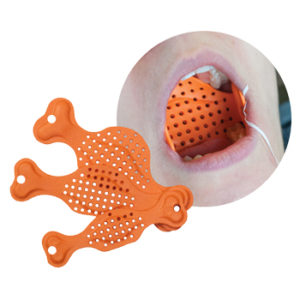 Did you know that dental items have been reported to be the second most common foreign object ingested or aspirated by adults? Zirc has developed Airway Armor, an innovative safety device designed to protect the patient’s airway. Airway Armor is the first of its kind on the market to serve as a barrier to swallowing or aspirating objects, allowing dentists to practice safely and confidently. This latex-free safety device is disposable and serves as a stable, comfortable, protective barrier in the mouth. It is easily placed and retrieved and is invaluable in all situations where other protective barriers are not viable options.
Did you know that dental items have been reported to be the second most common foreign object ingested or aspirated by adults? Zirc has developed Airway Armor, an innovative safety device designed to protect the patient’s airway. Airway Armor is the first of its kind on the market to serve as a barrier to swallowing or aspirating objects, allowing dentists to practice safely and confidently. This latex-free safety device is disposable and serves as a stable, comfortable, protective barrier in the mouth. It is easily placed and retrieved and is invaluable in all situations where other protective barriers are not viable options.
Airway Armor is a safe alternative to gauze packs, which typically cause patients discomfort. In addition, gauze packs can be difficult to place, absorb moisture and frequently need to be replaced. They have also been known to become lodged or aspirated into the airway, causing unnecessary risk to the patient. By contrast, Airway Armor is easy to place and durable, while giving practitioners full-mouth accessibility. It is available in three sizes – small, medium and large – to ensure a proper fit for any size mouth.
Dentists should ask themselves the following when considering Airway Armor:
- Is my practice doing procedures that expose our patients to the risk of ingesting or aspirating a dental object?
- What precautions do we take to protect our patients and our practice during these procedures?
Some dentists may have a few concerns, such as:
- “Will it make my patients gag?”
- Flexible, yet durable, Airway Armor can be positioned within the mouth to keep most patients comfortable without gagging.
- “Why is the cost so high for a disposable item?”
- Although Airway Armor is disposable, it is made of a durable material uniquely engineered to ensure its comfort, fit and effectiveness. It’s a simple, worthwhile precaution that can protect the practice from a costly malpractice lawsuit.
Airway Armor gives practitioners and patients alike peace of mind during treatment, including extractions, implants, restorations, orthodontics and pediatric procedures, by enabling them to provide the safest possible care to their patients.
Editor’s Note: Sponsored by Zirc.

